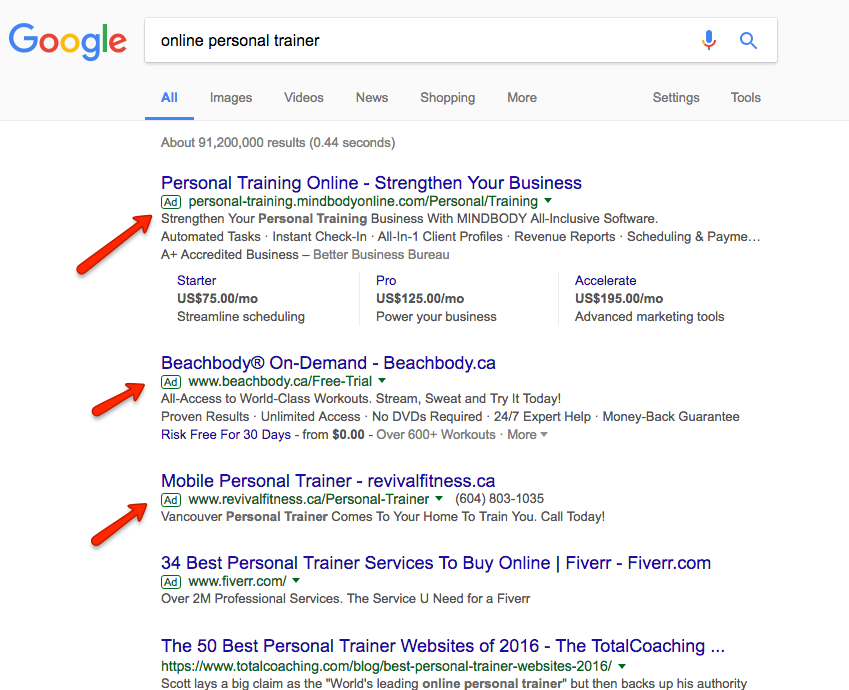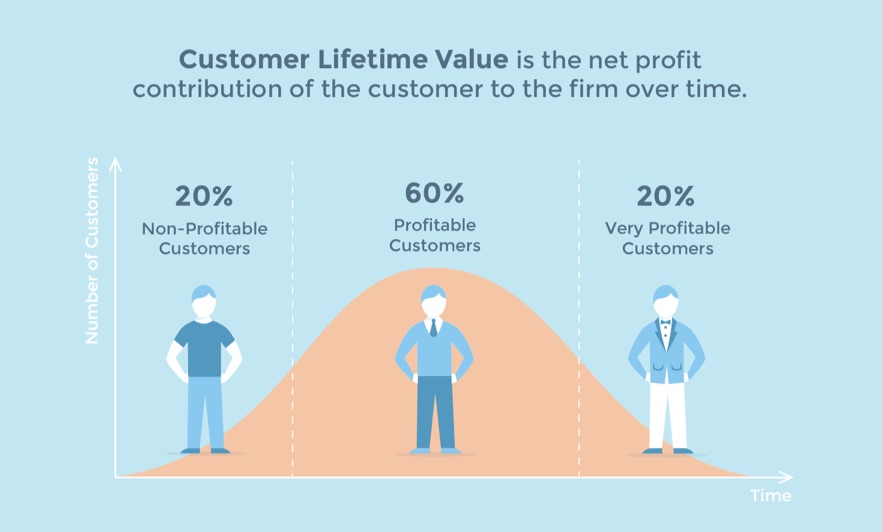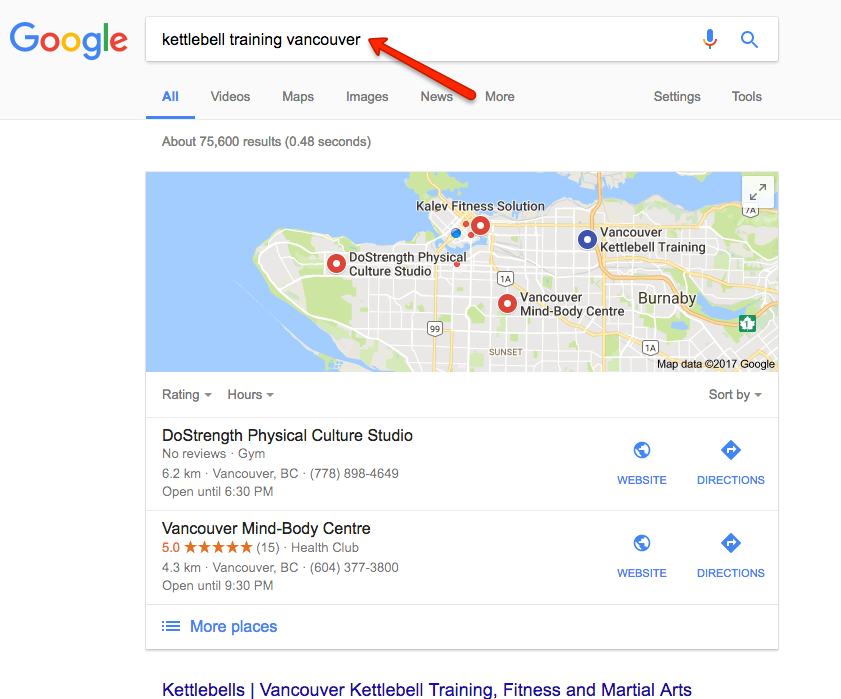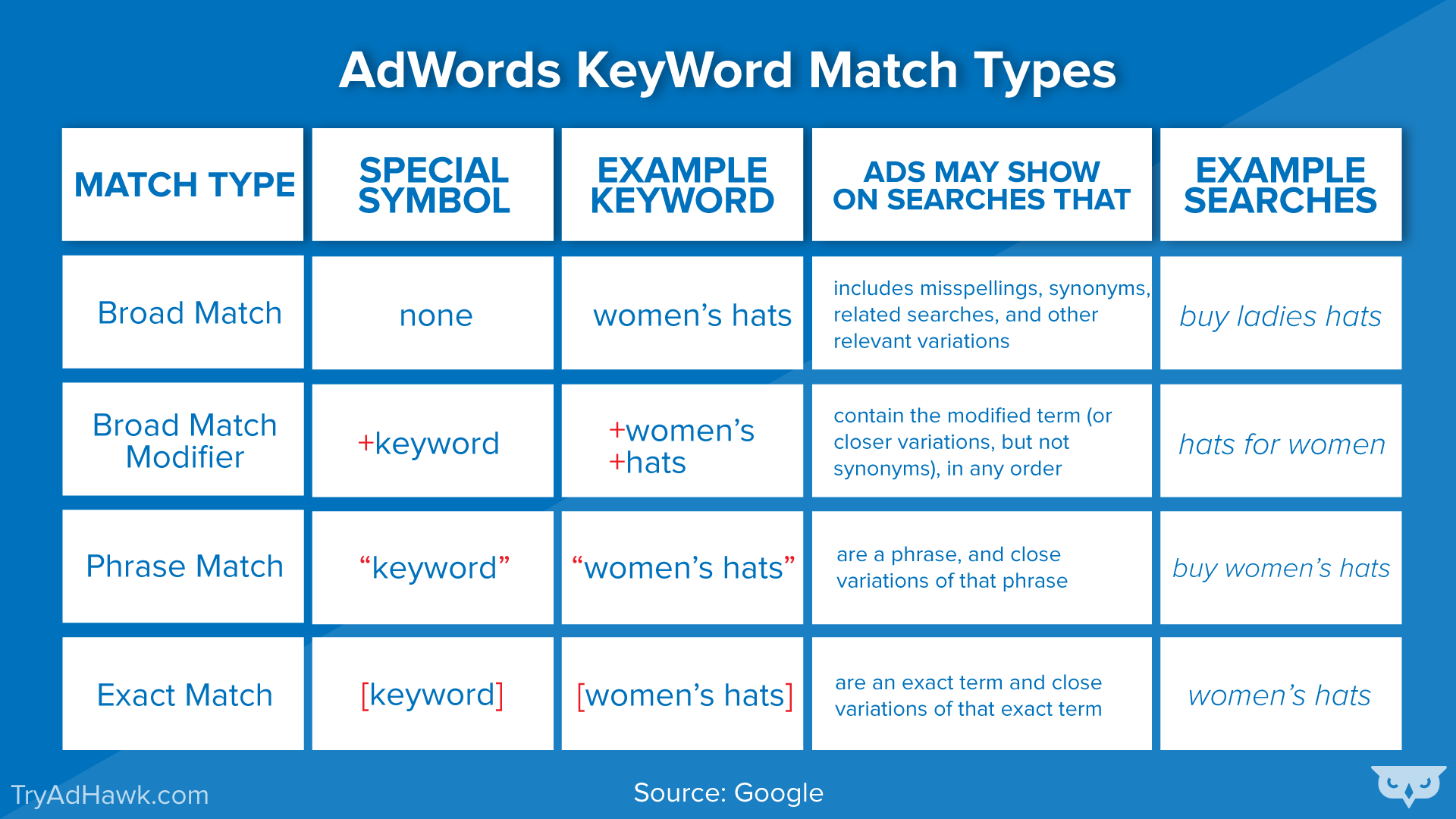Launched in 2000, Google AdWords may sound outdated in the fast-paced world of Digital Marketing. However, it’s vitally important that you consider AdWords as a source of traffic for your personal training website.

I will explain why AdWords remains an important source of traffic, how it compares with other sources, and what you need to do in order to succeed. For the purposes of this guide, I’m going to assume that you already have a website, and have the means of adding content quickly and easily.
How AdWords Has Evolved
Having been around for so long, it’s understandable that AdWords has gone through many changes. One of the most significant changes is the appearance of the ads.
In the early days, ads appeared above the organic (free) listings in a green-shaded area with the words ‘Sponsored Links’ above them.
Nowadays, it’s much harder to tell the difference between paid and organic listings, as Google tries to encourage people to click on paid ads more frequently. Up to four ads can appear at the top of the screen on a search results page; and on a mobile device, this pretty well dominates the ‘above the fold’ section of the page.

AdWords has also seen a variety of new ad formats and options over the years. From the early days of plain text ads on Google search results pages; there are now options for display advertising and remarketing of your website visitors or email lists.
Below is an example set of display ads that could "follow" you around the internet. Based on a person's click patterns and interests, Google can serve these ads very effectively.

Last but not the least, AdWords has changed in another important way - by price. Being an auction-based system, as more and more advertisers have flocked to AdWords, the prices have steadily increased.
Some advertisers are now deserting AdWords for the cheaper click costs offered by Facebook, but they could be missing an important point in the process.
How Does AdWords Compare with Other Traffic Sources?
Although this article is focused on AdWords, I have always encouraged businesses to find as diverse a range as possible of traffic sources. You should consider any source that your target market uses regularly.
Furthermore, look for sources for personal trainers that may include organic SEO, Facebook, as well as offline activities
How to Get More Organic Traffic (FAST) - 3 Simple Steps!https://t.co/BNbxtFWIzj via @backlinko #seo #tiptuesday
— Above The Fold (@werabovethefold) October 17, 2017
So let’s assume you have a balanced mix of traffic sources - where does AdWords fit into the overall mix? Well, although it may not be cheap, AdWords scores highly in terms of propensity to buy. If people have actively searched for a personal trainer or one of the specific services you offer, they are more than ready to buy. So compared to paid social campaigns, searchers are likely to be further along the buying process.
Over time of course, SEO can also bring you similar well-targeted traffic. However, getting SEO traffic is harder and can take much longer.
So, the overall role of AdWords is to bring you highly-targeted traffic quickly. Most noteworthy, it can be targeted locally, switched off if you get enough clients or need to go on a holiday, and switched back on again in the future.
So How Do You Succeed with AdWords?
AdWords is not easy, so you won’t succeed at it without a plan. However, with the right approach it can pay back well for personal trainers.
Here are a few simple pointers to help you plan your AdWords campaigns. Whether you try AdWords yourself or enlist external help, there are 11 things that you still need to know:
1. Know your customers
It’s useful to have a rough idea of the types of customers you want in terms of age, gender, attitudes and behaviours. You can use this information to create your customer avatar.
How to Easily Create Your First Ideal Customer #Avatar #persona #contentmarketing https://t.co/62UFoz9X2u pic.twitter.com/g70kzJj0nT
— Keith James (@mlmcoachsystems) October 16, 2017
There is now an element of demographic targeting available in AdWords. But, regardless of whether or not you use this targeting feature, it will be helpful to keep this in mind so you can ensure that messaging is appropriate for your chosen demographic.
2. Know the lifetime value
Because you’re paying for traffic, it’s important that you have a plan to ensure that you’re getting a good return. A key component of that is knowing the lifetime value of a customer.

Let’s say that you charge $50 per session (for in-person training) and you look at your existing clients and realize that the average customer goes on to pay for 12 sessions or more, spending $600.
In that scenario, if it costs you say $75 to acquire a customer, that probably represents a good return. However, if a typical customer disappears after two sessions, then AdWords may prove too expensive for you.
3. Know your offer
Before you launch a campaign, the cost of the traffic dictates that you must have some sort of a goal for what you want customers to do. So you may need an offer or it may be a simple ‘call to action’ such as ‘book your first session free’.
How To Create An Effective Call To Action - Guest Post By @lexieludesignerhttps://t.co/w00Ub1eiWv#cta #webdesign pic.twitter.com/TpPk9FmyG5
— Jon (@NewsJunkieJon) October 16, 2017
Either way, you must make it clear and make it easy for clients to respond. If you just send traffic to a bland page with no clear call to action, it will struggle to pay back your AdWords costs. You could even go a step further and offer a free guide with training tips in return for their email address.
4. Know your target
Within AdWords, you can target people based on their location, device type and demographics. You can also schedule ads for certain times of the day and the week.
As a personal trainer, location targeting is likely to be key. Most advertisers will choose their location and advertise in a set radius around this. By doing this, you will exclude any searchers further afield.
5. Know your keywords
Now it’s time to find what people search for. AdWords revolves around keywords, and their ‘Keyword Planner’ tool will tell you what they search for and in what quantities each month. This will help you focus your ads on the keywords that searchers actually use.
The research may bring out some surprises that you hadn’t thought of. If you offer very specific services such as kettlebell sessions, or if you offer services for specific sports, it’s important that you research keywords for these areas, rather than just ordinary ‘personal trainer’ keywords.

The more specific the keyword is, the less competition you are likely to have in your local area.
6. Know your match types
Not all keywords are created equal - AdWords includes different ‘match types’ for keywords. These include ‘exact match’ (your ads only show if exactly the chosen words and nothing else are keyed in), and ‘broad match’ (your ads show if any combination of your chosen words, or synonyms, and any other words are keyed in).
This is where AdWords does get quite technical. See the chart below to get a better idea as to how match types work:

You also have the opportunity to use ‘negative’ keywords - words you’d like to exclude from your campaign.
For example, some people may search for free training. These aren't going to be your ideal searchers since they aren't looking to pay for your services - you can exclude the word ‘free’ from your ads.
Or, as another example, they may be looking specifically for a female trainer, when you’re male (so ‘female’ could be added as a negative keyword).
If people search for training on specific sports, or specific training activities, you should also add these as negative keywords if you don’t offer a suitable service.
7. Know how to build your campaign
If you’ve followed the above steps, it’s now time to build your campaigns. It’s absolutely vital that you split your campaigns out if you offer a wide range of services, or offer a wide range of benefits.
So, if you offer triathlon training and want a specific campaign for that, keep it separate from say a generic personal trainer campaign or one for weight loss. It’s essential that the keyword, the AdWords ad and the landing page they arrive at, all follow a consistent theme. Otherwise, Google will give you a low ‘quality score’ for that ad, meaning you pay more for each click and can lose out on traffic.
8. Know your measurements
You must have a way of measuring the success of your AdWords campaigns. An element of conversion tracking is available in AdWords. You can use this for example to track how many people have completed your enquiry form as a result of AdWords campaigns. AdWords will then display a ‘cost per conversion’ for each campaign, ad and keyword.
For example if you spend $500 on a campaign and get 20 enquiries, that’s a cost of $25 per enquiry ($500 divided by 20 enquiries = $25 per enquiry).
If you're doing face-to-face personal training, it’s likely that the final client sign-up process is conducted in-person, so you will need to keep some sort of manual record of which clients came on board through AdWords. For online personal trainers, the final sale can easily be tracked automatically.
9. Know how to test and refine
Once your AdWords campaign is live, it needs to be refined and fine-tuned on an an ongoing basis. Over time, you can see the click-through rates of each keyword and ad. To optimise these over time, you need to eliminate under-performing keywords and ads, and test new ones.
10. Know how to remarket your audience
Once AdWords has brought people to your website once, you can now ‘remarket’ to them with follow-up ads so you stay in their minds and can persuade them to take that vital first step.
Which works best to encourage people to take action - Facebook or Google retargeting? Get the answer via @AgoraPulse https://t.co/95f2Ltn3wF
— Julia Bramble (@JuliaBramble) October 23, 2017
Choosing to work with a personal trainer is a big step for many people, and yet they found themselves on your site for a reason. ‘Nudging’ them this way can be really effective.
Remarketing regularly proves to be more cost-effective than marketing to cold customers from scratch; so you should consider it once your campaigns have been running a while
11. Know all your options
Nowadays, other advertising platforms have followed Google’s example and offer remarketing services for automated follow-up campaigns. Facebook, Twitter, and more recently, LinkedIn have created tracking codes you can copy to your website, enabling you to remarket to your site visitors via those ad platforms.
Here's a quick rundown on how you can remarket via Twitter. The other social platforms have similar setups.
Why is this so helpful?
Take this example: A visitor might come to your website via AdWords, but if you have the Facebook ‘pixel’ in place on your site and Facebook recognizes that visitor as a Facebook user, you can then remarket to that visitor via Facebook. So, as well as being an important channel in its own right, AdWords can also contribute to your marketing across other platforms as well.
As you can see, there is a lot to think about for Google AdWords, but it can be a key channel for personal trainers, bringing highly-targeted traffic to your site, quickly.
Although it may be competitive, with a methodical approach to campaigns and the right level of attention to detail, AdWords can help you find customers and also remarket to them across a variety of platforms.




